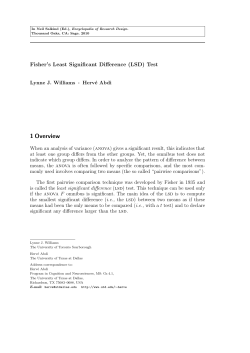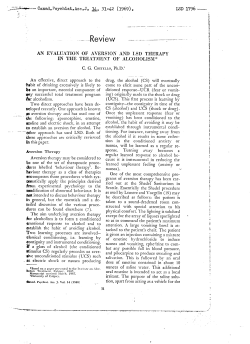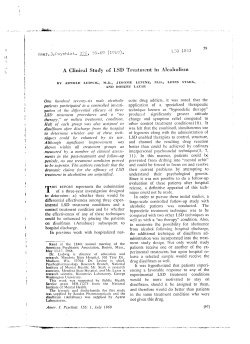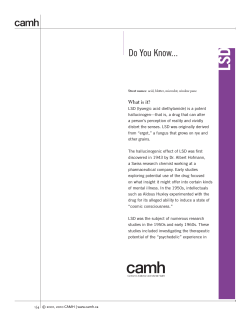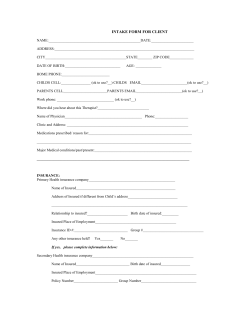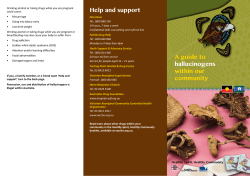
Document 149308
i . I_ -" Amer.J.Psychiat. 12fi, 4_1-487 (1969). LSO 1907 4" EXPERIENCE _'' 481 )ran, W. G.: Les,Iowa: The i7. LSD in the Treatment of Alcoholism BY F. GORDON JOHNSON, IV/.B., B.S. Ninety-five alcoholic patients took part in a single-blind study of the efficacy o[ LSD treatment, which /eatured four treatment groups: LSD given with and without a therapist present, sodium amobarbital-methamphetamine hydrochloride given with a therapist present, and routine clinic care. At one-year [ollow-up, with 87 percent of the patients reporting, all groups showed significant improvement in the areas of drinking and employment, but there was no significant difference between groups on any improvement criterion measure. This study thus lends no support to the claims made for the efficacy o1 LSD treatment in alcoholism, i r-r HE 20-YEAR USE of LSD in psychiatric 1_ disorder has been marked by a plethora of literary and clinical reports ranging from the mystical to the practical. In the realm of therapy, claims for the effectiveness of LSD treatment in many types of psychiatric disorder have been made, but few reports have been noted for their scientific ade- and Storm have pointed out in their critical review(14), these studies were characterized by inadequate controls, few consistently applied pretreatment and post-treatment criteria, and poor follow-up. Only two controlled evaluations of LSD in the treatment of alcoholism have been published. 1 These reports, by VanDusen and associates(18) and Smart(15), failed to show that the LSD experience, as described by them, was an effective adjunct to the clinical treatment of alcoholism. However, response to LSD is known to be highly dependent on such factors as patient expectation, setting, dosage, and therapist rapport. For this reason the results of these two controlledstudiescould only be assessed within the limitations imposed by their experimental settings, and it was considered of practical value to undertake a further LSD study with alcoholics, utilizing completely different experimental conditions and methodology. Methodology quacy. For instance, in the therapy of the The London Clinic of the Alcoholism and neuroses there is only one well-controlled Drug Addiction Research Foundation, Ontrial reported, and this notes lack o_ tario, established in 1954, uses primarily an significant improvement with LSD in cornoutpatient treatment approach with facilities parison with more orthodox therapies(12), for inpatient care available if necessary. In the therapy of alcoholism a number of Multiple professional disciplines are represtudies largely from Saskatchewan reported sented, with the greater part of therapy major success with a'single massive dose of being carried out by social work staff under LSD(2, 6, 10, 11, 16). However, as Smart medical and psychiatric supervision. Strong emphasis is placed on an atmosphere of free Based on a paper read at the 124th annual discussion and in-service education. Teachmeeting of the American Psychiatric Association, ing commitments to medical, psychology, Boston, Mass., May 13-17, 1968. Dr. Johnson is consultant psychiatrist. Alcohol- and social work students are heavy, and ism and Drug Addiction Research Foundation, 477 research is encouraged. Approximately 40 Waterloo St., London, Ontario. Canada, and aspercent of the patients are referred by a sistant professor, University of Western Ontario. The author wishes to thank Dr. Charles Aharan, physician or an agency, and most of the rest Dr. Murray Hoover. and the professional staff of the London branch, Alcoholism and Drug Addiction Research Foundation, for their encouragement 1Since this paper _,._, wrinen a third report has and active participation in this study, appeared in the 1tew_,': .i 9). ober 1969 Amer. J. Psychiat. 126: 4, October 1969 [63] 482 • are self-referred. They are drawn largely from a lower- to middle-class population, with an intake of approximately 220 a year. The author commenced the use of LSD in January 1965, gaining experience in its use in a prestudy phase by conducting 50 LSD sessions with a patient group with diagnoses of neurosis, alcoholism, and personality disorders; dosages of 50 to 3,000 #g. were used. A technique of split dosage was developed in order to achieve an optimal effect for the individual patient. Most clinic treatment staff, including the author, elected to take the drug under hospital conditions prior to the commencement of the study itself. All were positive in their reports on the experience, finding it personally meaningful and helpful. Intake to the scheme ensued from March 1965 to June 1966. A brief description of the procedure follows. At the patient's initial approach to the clinic, in person or by telephone, he made contact with the clinic secretary--a person skilled in her ability to encourage interaction and set the patient at ease. At this contact, the necessity of attending six hours of initial intake documentation and interviews was explained to the patient and an appointment date given. Acutely ill patients were always given initial medical assistance until their scheduled appointment date. Since delay in intake might constitute a selection factor in that only the more highly motivated patients might return, this delay period was kept to less than 14 days. At intake date the patients underwent a sixhour intake procedure with standardized quantifiable documentation covering background history, alcoholic history, and present social, domestic, and interpersonal relationships. They were then assigned in rotation to therapists. They also received psychological testing--Differential Personality Inventory(5), Quick (I.Q.) Test(l), and Hidden Figures Test(4), as well as physical and psychiatric examinations, Factors limiting a patient's inclusion in the scheme were as follows: The patient should be between 20 and 60, should have no severe liver, cardiovascular, or CNS disease, and should not be psychotic or have a history of previous psychotic breaks. He should admit to an alcohol problem and [64] LSD IN THE TREATMENT OF ALCOItOLISM should not have had more than one interview at the clinic within the last five years. If he was found acceptable, he was then asked during psychiatric examination whether he would agree to a 24-hour admission to a neighboring general hospital psychiatric unit within the next few weeks. He was told that the purpose of this was to administer one of a number of drugs to help him understand himself and his drinking behavior better and to aid the treatment process. If he agreed, he was then randomly assigned to one of four groups. I. (23 patients). The hospitalized patient was given 300 btg. of LSD in 10 ml. distilled water intravenously. One hour later another intravenous injection was given, the dosage dependent on clinical assessment. A nurse was present throughout the experience, but there was no therapist present. 2. (25 patients). The hospitalized patient was given 300 #g. of LSD in 10 ml. distilled water intravenously. One hour later another intravenous injection was given, the dosage dependent on clinical assessment. A nurse was present throughout with patient's therapist. 3. (22 patients). The hospitalized patient was given 3a gr. of sodium amobarbital (Sodium Amytal) and 30 rag. of methamphetamine hydrochloride (Methedrine) in 10 ml. distilled water. One hour later another intravenous injection was given, the dosage dependent on clinical assessment. A nurse was present throughout with patient's therapist. 4. (25 patients). There was routine clinic care with individual, group, and milieu therapy as determined by patient's therapist. There was no hospitalization for a special drug experience, the patient being told that, from analysis of his intake documentation, this was now felt to be unnecessary. During all hospital experience the psychiatrist held overall responsibility for the patient, but his activity varied with the .patient's group. In group 1, apart from clinical examinations and drug administration, the patient was left with a nurse in constant attendance for at least five hours or as long as necessary. She gave supportive nursing care but minimized verbal interaction. Amer. J. Psychiat. 126: 4, October 1969 :•i ALCOHOLISM F. GORDON than one the last five able, •he was examination a 24-hour Leral hospital t few weeks, In groups 2 and 3 the patient's therapist and psychiatrist acted as co-therapists. The therapist was with the patient for at least a four-hour period of active interviewing. The psychiatrist did not interact actively with the patient but was present intermittently to advise and to assist in standardizing the .f this was to :lrugs to help his drinking _e treatment en randomly interview technique. Interaction by the therapist was of a warm, supportive nature, aiding the patient to focus particularly on current problems and interpersonal relationships. However, this emphasis did not exclude utilization of such occurrences as vitalized paD in 10'ml. abreaction or transcendental experiences. Since many previous studies and our Follow-up questionnaires were phrased and scored in a similar manner to initial intake le hour later as given, the _sessment. A the experipresent, _italized pa- experience have emphasized that the LSD effect was so distinctive that the therapist could not fail to be aware of its use, this study was planned to be single blind for the patient. In all hospital groups, the patient was questionnaires to allow direct comparison. A two-year follow-up is now in progress. D in 10 ml. _e hour later as given, the __sessment. A vith patient's admitted on the morning of therapy, he was to have had no phenothiazines in the last 24 hours and no MAC inhibitors in the preceding 14 days. A voice-actuated tape recording was taken and used for further analysis and supervision of interview techniques. The room used for the experience had simple furnishings and was quiet, shaded, and restful. A Posey restraint belt was used around the patient's waist so that he could move around in bed but could not leave it. He was reassured as to the use of the belt and thereafter generally accepted it without question. About six hours after the first intravenous injection, chlorpromazine, 200 rag., and a combination of amobarbital sodium and secobarbital sodium (Tuinal), l k gr. orally, were given. This was repealed for night sedation. On the following day the patient was questioned by the psychiatrist concerning his experience, and he completed standard forms, including the Linton and Langs Questionnaire(8). His therapist also interviewed him and arranged further contacts at the clinic as indicated. Follow-up as close to the 12-month mark as possible following the patient's entry into the scheme was made by independent trained observers who were unaware of the original group to which the patient belonged. A follow-up was also made on those patients who refused the hospital scheme but were otherwise found suitable for it. Selection processes entering into the formation of final patient treatment groups are necessarily of importance and are detailed in table 1. The 74 dropouts prior to intake date were incompletely documented, but at least 44 percent were known to be of "skid row" background and were perhaps inadequately motivated to wish to spend the required six-hour intake time. The 66 dropouts during the intake procedure were primarily patients who came seeking acute emergency care only and had no interest in continued contact. The next reduction of 42 patients constitutes the group rejected on medical, psychiatric, or other grounds inherent in the scheme. Details are given in table 2. The final reduction group of 60 patients refused the hospital experience but were otherwise found suitable for it. )italized paamobarbital of methamIhedrine) in later another , the dosage :nt. A nurse tient's therawas routine group, and by patient's lization for a _atient being his intake felt to be : the psychiliLy for the .'d with the apart from administraa nurse in ;t five hours 'e supportive rbal interac)ctober 1969 JOHNSON • Amer. J. Psychiat. 126: 4, October 1969 483 TABLE 1 Stages in Reduction to FinalScheme Size NUMBER OFPATIENTS 337 263 197 155 95 STAGE REDUCTION Originalclinic contact Attendanceat initial intakeprocedure Completion of intakeprocedures Suitablesubjectsfor hospitalexperience Agreementto and completion of scheme 74 66 42 60 Results Patient Intake TABLE 2 Reasons for Rejection from Scheme NUMBER REASON REJECTED Youngerthan 20 or older than 60 8 Severeliver, cardiovascular,or CNSdisease 6 Psychotic,prepsych0tic,or mental defect 5 Nonadmission of alcohol problem 6 Formerpatientwithmorethanone interviewin the past five years 8 Patient assignedto social workstudent 9 Total 4"-2 [65] 484 i LSDIN THETREATMENT OF ALCOHOLISM Chi-square analysis of the final 95 patients in groups I to 4 regarding age, sex, referral source, severity of drinking, marital status, education, type and length of employment, and accomnlodation demonstrated the lack of any significant (p = .05 level) difference between groups. Thus, in terms of demographic variables, the final group was a homogeneous one, and table 3 indicates some of these parameters taken across all groups. Eighty-seven percent of the subjects in groups 1 to 4 were successfully followed up and their responses to questionnaires corroborated where possible by information from relatives. In addition, 58 percent of the refusal group were successfully contacted for follow-up. Responses were compared for prc- and post-differences in the areas of: 1) drinking--abstinence, drinking practices (frequency, length of benders, etc.), consequences of drinking (loss of jobs and friends, physical complications), and attitudes toward drinking (recognition and acceptance of need for sobriety); 2) employment; 3) accommodation; 4) social relationships; and 5) marital status. An analysis of variance-repeated measures design was used to assess these pre- and postmeasures. Table 4 gives the result of this analysis across criterion measures. A statistically significant improvement (p < .01) occurred across all four groups on most drinking in- , t I I t dices. Improvement approaching significance (p < .10) occurred in employment and "attitudes to drinking" data. However, there were no significant differences between groups; i.e., overall improvement occurred, but the use of drug therapy in the hospital TAKEN ACROSS ALL DIFFERENCES BETWEEN PRE-, POST-DIFFERENCES CRITERIONTREATMENT GROUPSTREATMENT GROUPS Abstinence p<0.01 NS Drinking practices p<0.01 HS Consequences of drinking p < 0.01 NS Attitudes toward drinking 0.10 0.05 NS Employment 0.10>> pp >> 0.05 NS Accommodation NS NS Social relations NS NS Maritalstatus NS NS did not confer special advantages over routine clinical therapy. Pretreatment and posttreatment measures of marital status, accommodation, and social relationships showed no changes approaching significance. The number of patient contacts with the clinic from entry into therapy to termination also did not differ significantly between groups (16.11 ± so 11.07 contacts). Dosage The method of fractionation of dosage was found to be effective. Intravenously, a definite LSD effect was usually experienced in five to 15 minutes. However, if there were few perceptual changes or autonomic manifestations within 45 minutes, dosage was boosted, usually from 300 to 500 p,g. In all cases this produced a significant drug effect.The optimumpoint for LSDtherapy TABLE 3 Grouped Demographic Characteristics t I ! TABLE 4 Analysis of Variance.Repeated Measures CHARACTERISTIC Age Sex Male Female was considered to beat a level where the patient was fully oriented and still capable of meaningful interaction with the therapist. MEAN He usually experienced considerable subjec40.90± SO 9.95 tive alteration of perceptual, cognitive, and 'affective levels of functioning with much 87 symbolic imagery. In the case of sodium 8 Socialclass 3.53± SD 0.93 amobarbital_methamphetamine hydrochloYearsof problemdrinking 8.15±SD 7.68 ride therapy, the patient remained fully IQ 99.31± SD15.73 oriented throughout, with pressure of speech , Socialstability(Straus-Bacon[17]) 3.14+SD 1.20 and marked affect. Table 5 indicates the Years0f education 9.95± SD 2.28 level of medication used. [66] Amer. J. Psychiat. 126: 4, October 1969 ALCOHOLISM F. GORDON JOHNSON 485 TABLE 5 DrugDosage Results indicate that LSD in this setting conferred no evident advantages over more conventional modes of therapy. Thus, corroboration under different experimental conditions of the findings of two previous controlled studies in the literature lends further weight to the rejection of LSD as a significant drug in the treatment of alcoholism. In particular, this study was designed to meet possible criticism of the Toronto LSD study(15) in two areas: 1. The patient was not supervised in LSD therapy by his regular therapist but by a comparative stranger. Because of the importance of "set" in the LSD experience, it was possible that the absence of the usual therapist might have influenced the experience negatively. Care was taken in our study to ensure good rapport and close contact between patient and therapist before, during, and after the experience, but this feature still led to no apparent longterm benefit. It had also been hypothesized that an intense affective hospital experience early in the patient's contact with the clinic might facilitate positive transference and cement patient-therapist rapport. However, as measured by numbers of contacts by a patient with his therapist, no difference between groups could be established, is a treatment in itself or whether it only facilitates psychotherapy in the same sense as SodiumAmytal. ." Sargentand Slater(13) write in the same vein. In addition, other nontherapy studies report that "normal" subjects report themselves capable of greater insight and enhanced enjoyment of life after the experience(3). Group 1 (LSD given without a therapist present)wasincludedin the studyto clarify the question of how important a therapist was in the experience. As part of documentation following his drug experience, the patient reported on various subjective parameters relating to the occasion. These will be fully reviewed in a subsequent paper, but relevant to this discussion is the finding that between groups 1 and 2 there appeared to be no essential differences in affective, cognitive, and perceptual experiences under the drug. In addition, groups 1, 2, 3, i.e., with or without therapist, reported either no change after the experience or, more usually, some degree of lessening of tension, depression, irritability, and isolation. In addition, patients usually felt more optimistic about the future and believed they had increased insight. Where the therapist was present he was, however, usually felt to have been of great assistance, mainly as a supportive agent but also in his capacity of helping to guide the experience toward significant material. The tentative conclusion may be drawn that the patient was able to obtain shortterm benefit in two ways: by the.support and direction of the therapist who helped him through often frightening intense drug experiences and by some nonspecific effect of the hospital drug experience. This action may lie in the strong support of extra attention and hospitalization or in a drug 2. Instead of the high fixed dosage of the Toronto study, a flexible dosage was used, regulated to the patient's needs. Again, no apparent increase in efficacy of treatment occurred, effect common to LSD and sodium amobarbital-methamphetamine hydrochloride. Since both of these drugs induce intense affective release, it is possible that some neurophysiological'mechanism resultin_ from strong af- Intrinsic Action of LSD fective discharge produces jective improvement noted. _easures :ENCES BETWEEN rMENT GROUPS NS NS BASIC ADDITIONAL LSD,300 _g. 264.3± SD89.5 Sodiumam0barbital(SodiumAmytal), 33,_gr. 2.67 ±SD 1.81 Methamphetamine hydr0chloride (Methedrine), 30 rag. 9.05 ± SD 10.98 NS Discussion N'S NS NS NS NS es over rount and postatus, accom_sshowed no _. The num..clinic from also did not ps (16.11 - 1 of dosage avenously, a experienced ,er, if there r autonomic ltes, dosage to 500 /xg. fificant drug _SD therapy .1 where the still capable he therapist. :able subjec.gnitive,and withmuch of sodium hydrochloRained fully _eofspeech ldicates the Dctober 1969 There has been uncertainty as to whether LSD has an effect per se on personality modification or whether a therapist is necessary to the experience. Kalinowsky(7) writes: "The question remains whether LSD ,Amer. J. Psychiat. 126: 4, October 1969 the marked sub- "Set" Toward LSD Apart from two ex-mental-hospital patients who were more knowledgeable regarding treatment, apparently no patient was [67] "'_ .... 486 :...:, , • ,_ _t ;.i_5 ' "'_ _', '_ i._ [i; i! ' _- .: " f • _''' ",'_ : T " " "set" about LSD before and thus a stereotyped be expected. In this effects were minimal: experienced perceptual their experience-response might well study suggestibility When the subject and other changes, part of drug action, he washis encouraged to continue to thinkand about drinking problems and life situation. Under these he was reassured that this was an expected circumstances, it is of interest that only three out of 48 patients experienced definite transcendental effects in the usual sense of union with the universe or God. However, many did experience a sense of extreme closeness and understanding, sometimes curred so frequently that, considering the absence of any patient expectation of drug effect, one is led to the conclusion that this may be a basic affective change specific to LSD. It is possible that the so-called transcendentalstate may be a combination of this basic affect with intellectual and mystic overtones induced by therapist bias and the patient's knowledge of the litera- t /' / / ture. 4. ALCOHOLISM of alcohol- Ditman, K. S., Hayman, M., and Whittlesey, J. R. B,: Nature Claims following LSD, J.and Nerv.Frequency Ment. Dis.of 134:3461962. I.352, Stud. Alcohol 20:577-590, 1959. French, J. W., Ekstrom, R, B., and Price. L. A.: Manual for KitPrinceton, of Reference for Cognitive Factors. N. 1.:Tests Educational Testing Service, 1963. 5. Jackson, D. N., and Messick, S.: The Differential Personality Inventory, 1964. D.P.I. (Form A). London, Western Ontario Canada: (authors), University of 1964 (pro- cessed). 6. Jensen, S. E., and Chronic 7. Ramsay, Alcoholism Diethylamide, 188, 1963. Kalinowsky, Canad. R.: with Treatment of Lysergic Acid Ass. J. 8:182- Psychiat. L. B., and Hoch P. H.: Somatic Treatments in Psychiatry. New York: Grune & Stratton,1961,p. 121. 8. Linton, Iq. B., and Langs, R. J.: Subjective Reactions to Lysergic Acid Diethylamide (LSD-25), Arch. Gen. Psychiat. 6:352-368, 1962. 9. Ludwig, A., Levine, J. Stark, L,, and Lazar, R.: A Clinical Study of LSD Treatment in Alcoholism, Amer. J. Psychiat. 126:59-69, 1969. 10. MacLean, J. R., MacDonald, D. C., Byrne, U. P., and Hubbard, A. M.: The Use of LSD-25 in the Treatment of Alcoholism and Other Psychiatric Problems, Quart. J. Stud. Alcohol In an alcoholism clinic setting, a singleblind study of LSD in the treatment of alcoholism was undertaken. Ninety-five patients were randomly assigned to four groups. These groups were: 1 ) LSD given without a therapist present; 2) LSD given with a therapist present; 3) sodium amobarbital-metbamphetamine hydrochloride given with a therapist present; and 4) routine clinic care. At one-year follow-up, 87 percent of patients were contacted. All groups improved significantly across drinking employment indices, but there was OF 1. Ammons, R. B., and Ammons, C. H.: The Quick Test. Missoula, Test Specialists. 1962. Mont.: Psychological 2. Chwelos, N., Blewet, D. B., Smith, C. M., and Hoffer, A.: Use of D-lysergic Acid Diethylamide in the Treatment of Alcoholism, Quart. Summary _ TREATMENT REFERENCES • _' THE This situation seems novel in since most patients are spontaneously referred to as compassion, toward those in their immediate environment and in fantasy toward their family and other associates. This affective state oc- ! /' this likelihood. the literature IN made for LSD in the treatment ism. 3. !::iJ_i'i(i / aware of the possibility that be might be receiving LSD and did not even question :' i' ] LSD 11. 22:34-45, O'Reilly, 1961. P. O., and Reich, G.: Lysergic Acid and tbe Alcoholic, Dis. Nerv. Syst. 23:331334. 1962. 12. Robinson, J. T., Davies, L. S., Sack, E. L. N. S., and Morrissey, J. D.: A Controlled Trial of Abreaction with Lysergic Acid Diethylamide (LSD-25), Brit. J. Psychiat. 109:46-53, 1963. 13. Sargent, W., and Slater, Physical Methods E.: An Introduction of Treatment to in Psychiatry. Baltimore: Williams & Wilkins Co., 1964, p. the had and no • 14. Smart, R. G., and Storm, T.: The Efficacy of 197. . LSD in the Treatment of Alcoholism, Quart. J. Stud. Alcohol 25:333-338, 1964. t5. Smart, R. G., Storm, T., Baker, E. F. W., and Solursh, L.: Lysergic Acid Diethylamide significant difference between groups on any improvement criterion measure. This study therefore lends no support to the claims Toronto: University of Toronto Press, 1967. 16. Smith, C. M.: A New Adjunct to the Treatment of Alcoholism: The Hallucinogenic [68] (LSD) in the Treatment of Alcoholism. Amer. J. Psychiat. 126." 4, October 1969 iii 1 ALCOHOLISM i at of alcohol- ts, C. H.: The Psychological dth, C. M., and AcidDiethyla)holism, Quart. 1959. d Whittlesey, J. tcy Claims Dis.of 134:346, and Price, L. ence Tests for N. J.: EducaS.: The Dif', 1964. D.P.I. University of 1964 (pro: Treatment of Lysergic Acid Ass. J. 8:182P• H.: Somatic gork: Grune& J.: Subjective Diethylamide at. 6:352-368, L., and Lazar, Treatment in _:t. 126:59-69, F. GORDON JOHNSON Drugs, Quart. J. Stud. Alcohol 19:406-417, 1958. 17. Straus, R., and Bacon, S. D.: Alcoholism and Social Stability, Quart• J. Stud. Alcohol 12:231-260, W., 1951. 18. VanDusen, Wilson, W., Miners, W., and Hook, H.: Treatment of Alcoholism with Lysergide, Quart. J. Stud•Alcohol 28:295-304, 1967. 487 medication• He has also wisely incorporated the use of a behavioral end point for determining dosage in one of the patient groups rather than only utilizing a fixed dose throughout all patient groups• JACK H. MENDELSON, M.D. (Chevy Chase, Md.).--This study represents an objective attempt to assess the efficacy of LSD treatment of alcoholics. Dr. Johnson's work is characterized by a high degree of methodological sophistication coupled with a recognition that the empirical value of drug therapies in any behavioral disorder is difficult to demonstrate in tightly controlled experimental studies. Dr. Johnson is quite correct in pointing out that most of the attempts that have been made to evaluate LSD treatment in alcoholism lack adequate controls and explicit criteria for longterm evaluation. The selection of patient groups for this study is well described, and given the limitations of matching subjects for outpatient studies in alcohol-related areas, the subject selection and grouping have been carried out reasonably well. The experimental design is good. The author has wisely included the use of non-LSD The findings of this study highlight the lack of efficacy of LSD treatment as carried out under the conditions described. Moreover, these studies show that the presence or absence of a therapistduring the LSD session makes little difference in eventual outcome. I think this was an important control to incorporate since there have been a variety of quasimystical reports concerning the therapist's importance and role during LSD administration. This was an important study to have carried out, but I find it surprising that one would entertain the hypothesis that a single or short-term exposure to LSD or any drug would produce significant therapeutic results for alcoholics. Alcoholism is a chronic _isease, and it would be surprising to find that any one-shot approach would affect the course of a disorder influenced by multiple interacting biological, psychological, and sociocultural factors. The negative results obtained by Dr. Johnson in studies carried out under carefully controlled conditions highlight the need for patience and balance before acceptance of panacea therapeutics. This statement should not be interpreted as a condolence for therapeutic nihilism but rather a plea for better design and more systematic studies of drug treatment for medication alcoholic DISCUSSION given intravenously as well as no patients. • C., Byrne, U. Jse of LSD-25 ;m and Other Stud. Alcohol Lysergic Acid Syst. 23:331_ack, E. L. N. rolled Trial of Diethylamide ):46-53, 1963. ntroduction to in Psychiatry. Co., 1964, p. The folly of mistaking a paradox for a discovery, a metaphor for a proof, a torrent of verbiage for a spring of capital truths, and oneself for an oracle, is inborn in us. _PA'OL _¢'AL_RY he Efficacy of ,lism, Quart. J. E. F. W., and Diethylamide Alcoholism• Press, 1967. junct to the tallucinogenic _ctober 1969 Amer. I. Psychiat. 126: 4, October 1969 [69]
© Copyright 2025

